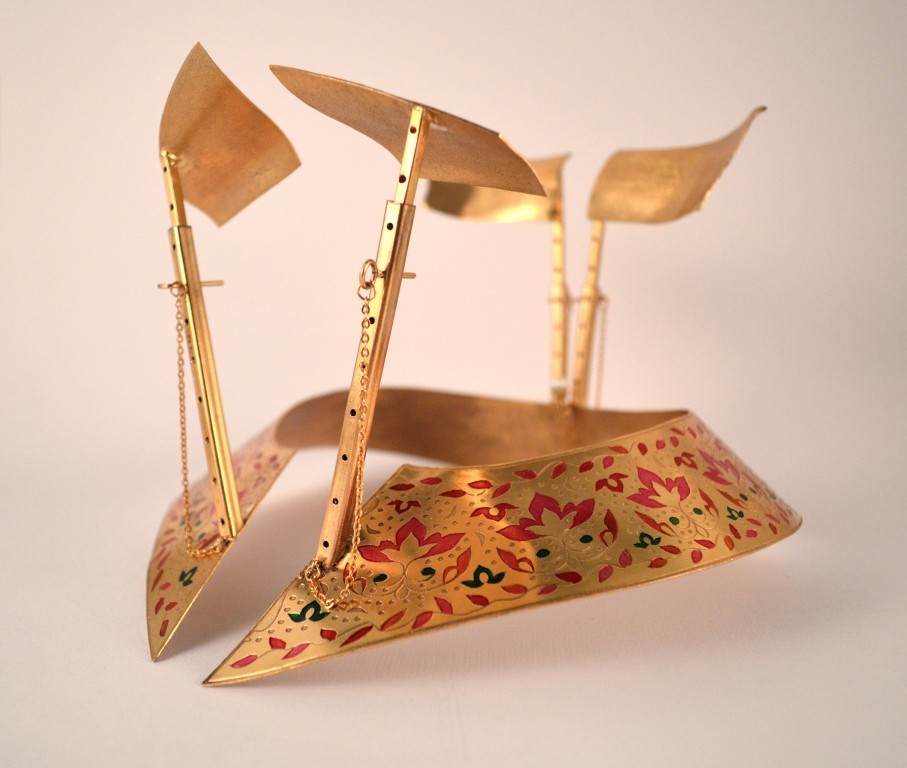
In her solo exhibition at Rohtas 2, Sara Aziz defies the easy classifications of art and craft, simultaneously challenging the notions of beauty

It may be rare but not impossible to have your cake and eat it too. On seeing Sara Aziz’s work, currently on display at the Rohtas 2, Lahore, one notices that two functions of an object can still be possible without the expense of one to the other.
Man has always been searching for the utility of things in his surroundings. The history of human development is a story of how humans have discovered the uses of stone, wood, water, fire and other elements of nature. This list also includes man-made articles because everything that is created for one purpose does have other functions which range from practical to decorative. Often an item made by man changes its function with the passage of time and with the shift in cultural context. One recalls the fate of a Coca-Cola bottle which fell from a plane flying on a desert in Africa and was thought of as an idol sent by gods by a remote tribe in the movie The Gods Must be Crazy (1984). This is one example of how a mundane item can become a precious and holy object with villagers fighting over to possess and pay respect.
What takes place in the film happens in real life too (hence the invisible difference between cinema and life!) as articles which were produced for a specific function -- religious, ritualistic to domestic -- are now viewed and venerated as works of art. Or, on the other hand, some pieces which were created as works of art have been transformed into commercial items for public consumptions. If our art museums are filled with statues and iconic paintings which were used for the purpose of worship, likewise the same museums market replicas of famous works of art in post cards, cups, bags, T-shirts or in other artefacts. Also a number of toys, pottery, armoury, garments, all functional and from ancient periods and other cultures, are now a part of museums to amuse and educate visitors.
The changing perceptions and purposes of a product concern a creative person because, for an artist today, his creation apart from revealing his ideas and emotions has multiple other dimensions. Along with the aesthetic and pictorial side, a work of art contributes towards a deeper understanding of existence in a society. It also documents the era and surroundings. Besides these, it can be used for a specific need: to put on one’s walls or place at someone’s house. For the maker, gallery and collector it has monetary value and can be sold and bought, with profit.
The question of a balance between beauty and utility has always been an issue for creative minds. A similar concern is found in the work of Sara Aziz, as her pieces can be located in a territory between pictorial pleasure and practical purpose. At her solo exhibition (being held from October 8-22, 2015), a number of objects are displayed which can be classified as works of art or pieces of jewellery. Apart from a set of four necklaces, the gallery contains six strange-looking items, rather devices, which are gold-plated and fabricated with utmost care and skill.
These unusual exhibits are titled The Nose Mould, The Ear Puller 2, The Pouter, The Face Lifter, The Neck Elongator and The Frown Fixer, and due to their precision in making, one realises these must serve the function for which they are designed and created. However, one is not sure because while examining them one becomes confused on the utility of these objects. In appearance these look more like works of contemporary sculpture, despite being made with materials employed to make jewellery.
Regardless of their practicality and the link between art and craft, these pieces allude to the distinction of pleasure and pain. Because all these objects, in essence, are designed and aimed for enhancing the beauty of a woman, but in their structure are tormenting devices. Cloth pegs to fix ear, metal pins to lift the face, and supporting strips to extend the neck if on the one hand appear as individual and independent works of sculpture, they also signify how beauty combines with a sense of suffering.
This aspect of prettiness and pain seems to be the main concern of Sara Aziz as, viewing her works, one realises that nobody is going to put these devices on body or face. Nevertheless, these are her comments upon the ideas and idealisation of beauty manifested in metal. These also convey how a woman has to go through the painful process of changing her natural state for the pleasure of a man’s eye and his approval.
In an interesting manner, the work of Sara Aziz defies the easy classifications of art and craft, and simultaneously challenges the notions of beauty which are purely based upon women’s choice and freedom. It indicates how a gender is subjugated to change its appearance on the demand of another gender. Hence, her jewellery-like pieces appear not dissimilar to torture tools by various forces in their occupying territories (like the display of such instruments on the top floor of National Museum of Bangladesh in Dhaka).
This link of beauty with one’s gaze is illustrated in Sara Aziz’s necklaces which have bases made of words in English such as ‘sexy’, ‘skinny’, ‘hot’ and ‘fair’, but all composed in Kufic/Arabic script, thus implying how the world is not what is projected on the surface.